![]()
![]()
![]()
Use LEFT and RIGHT arrow keys to navigate between flashcards;
Use UP and DOWN arrow keys to flip the card;
H to show hint;
A reads text to speech;
66 Cards in this Set
- Front
- Back
|
What are the types of Hemoglobin disorders?
|
- Structural variants of globins
- Thalassemias (underproduction of normal globin) |
|
|
What kind of anemia do Thalassemias cause?
|
Microcytic / Hypochromic Anemias of varying severity
|
|
|
What chromosomes are the α and β globin genes on?
|
- 1 β gene on Chromosome 11
- 2 α genes on Chromosome 16 |
|
|
How many different types of abnormal hemoglobins are there? How do they form?
|
- >500 structural variants
- Most are single AA replacements in globin molecules - Occasionally 2 aa replaced, deletions, insertions, chain elongations, or fusion genes - Most are clinically silent |
|
|
What are the consequences of structural globin abnormalities dependent on?
|
- What globin gene is affected (eg, δ gene mutations are inconsequential)
- Location of substitution in tertiary structure and/or quarternary structures of globin or Hb molecules |
|
|
What are the potential consequences of structural globin abnormalities?
|
- Sickling
- Instability (degrades prematurely) - Altered O2 affinity (↑ or ↓) - Increased susceptibility to oxidation to methemoglobin (ferrous iron oxidized to ferric iron and unable to bind O2) - Under-production - Various combinations of above |
|
|
How do you diagnose structurally abnormal Hb?
|
- Hemoglobin electrophoresis (gel or capillary)
- High performance liquid chromatography (HPLC) - Other advanced techniques (isoelectric focusing, globin chain electrophoresis, gene mutation analysis) |
|
|
What is the procedure for a routine hemoglobin electrophoresis?
|
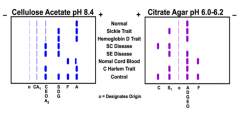
- Typically performed in parallel w/ alkaline and acid buffers
- HbA has isoelectric point of 6.8 so in alkaline buffers will migrate to anode (+) but in acidic buffers will migrate to cathode (-) |
|
|
How does the buffer affect the migration of Hemoglobin on electrophoresis?
|
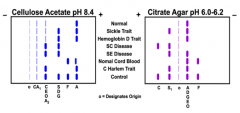
Alkaline Buffer:
- HbA has negative charge → migrates towards anode (+) - Migration of other Hb depends on net charge Acidic Buffer: - HbA has positive charge → migrates towards cathode (-) - Migration of other Hb depends on net charge and interaction w/ components of media (slightly more complicated) |
|
|
What is the procedure for an HPLC electrophoresis?
|
1) Fully automated cation exchange chromatography method
2) Whole blood method (whole blood hemosylate) - Hb adsorbed onto resin particle in column - Different species differentially eluted based on affinity for resin by gradually changing ionic strength of elution buffer - Hb come off column at highly predictable retention times |
|
|
What determines the extent of HbS polymerization in Sickle Cell Disease (SS)?
|
Time and concentration dependent
|
|
|
What are the factors affecting the concentration of HbS (and thus influencing the polymerization of HbS)?
|
- Percentage of HbS of total Hb
- Total Hb concentration in RBC (MCHC) |
|
|
What affects the percentage of HbS of total Hb?
|
- Homozygous vs heterozygous Sickle Cell Disease
- Presence of other Hb species (eg, HbF) |
|
|
What affects the total Hb concentration in RBCs (MCHC)?
|
- Increased in states of cellular dehydration
- Decreased when there is co-existant thalassemia |
|
|
What are some examples of how time affects the amount of sickling in HbS?
|
- Sickling is enhanced in anatomic sites w/ sluggish flow (eg, spleen and BM)
- Blood flow through microvasculature retarded in certain pathologic states (eg, inflammation) |
|
|
What clinical settings predipose to sickling? Why?
|
- Hypoxia
- Acidosis (shifts O2 dissociation curve to R causing increased deoxygenation of HbS) - Dehydration (hypertonicity causes RBC dehydration) - Cold temperatures (probably a result of peripheral vasconstriction w/ resultant sluggish flow) - Infections (multiple mechanisms) |
|
|
At what PaO2 do SS (HbS) cells begin to sickle?
|
~40 mmHg
|
|
|
What happens to a RBC that sickles?
|
- Initially reversible process
- After multiple sickling/unsickling cycles, membrane damage produces an irreversibly sickled cell - RBC lifespan decreased to 20 days (from 120) |
|
|
What are the effects of RBC sickling?
|
- Chronic hemolysis (correlates w/ number of irrev. sickled cells)
- Microvascular occlusion w/ resultant tissue hypoxia and infarction (does not correlate w/ irrev. sickled cells, rather is related to increased "stickiness" of SS RBCs b/c of membrane damage) |
|
|
How are newborns affected by Sickle Cell Disease?
|
- Clinically fine because of high HbF levels
- Hematologic manifestations begin by 10-12 weeks of age |
|
|
What are the clinical manifestations of Sickle Cell Disease?
|
- Severe anemia
- Acute pain crises - Aplastic crises - Auto-splenectomy or splenic sequestration crises - Acute Chest Syndrome - Strokes - Megaloblastic anemia - Growth retardation - Bony abnormalities - Leg ulcers - Infections - Cholelithiasis |
|
|
What causes acute pain crises in Sickle Cell Disease?
|
Vaso-occlusion, particularly in BM
|
|
|
What causes auto-splenectomy in Sickle Cell Disease? How common?
|
- Repeated episodes of splenic infarction, results in shrunken, fibrotic, non-functional spleen
- Seen in essentially all adults w/ SS disease |
|
|
What causes Acute Chest Syndrome in Sickle Cell Disease?
|
- Severe complication, major cause of death
- Results from pulmonary infections or fat emboli from infarcted BM - Sluggish blood flow from inflammation causes sickling and vaso-occlusion, triggering vicious cycle |
|
|
What is the major cause of death in Sickle Cell Disease
|
Acute Chest Syndrome - results from pulmonary infections or fat emboli from infarcted BM
|
|
|
What causes Aplastic Crises in Sickle Cell Disease?
|
Acute decrease in RBC production, typically from parvovirus B19 infection
|
|
|
What causes Splenic Sequestration Crises in Sickle Cell Disease? What can it cause?
|
- Acute pooling of blood in spleen
- Precipitous drop in hemoglobin - Potential for hypovolemic shock - Important cause of morbidity and mortality in children w/ SS disease |
|
|
What is an important cause of morbidity and mortality in children w/ SS disease?
|
Splenic Sequestration Crises
|
|
|
What causes Megaloblastic Anemia in Sickle Cell Disease? What can it cause?
|
- Folate consumption because of chronic erythroid hyperproliferation
- Insufficient folate levels |
|
|
What are the laboratory findings in Sickle Cell Disease?
|
- Chronic Anemia (Hb: 5-11 g/dL, normally ~7g/dL)
- ↑ Bilirubin - Sickled cells, target cells, and polychromasia - ↑ Reticulocytes - Normal MCV - Post-splenectomy changes in adults |
|
|
How common is "S-trait"? Clinical implications?
|
- 8% of African Americans have S-Trait
- Clinically benign: no anemia, normal RBC survival, no crises or other complications in majority, normal PB smear - May be mild, sub-clinical kidney damage: impairment of urine concentration, microhematuria |
|
|
What kind of Hemoglobin is found in patients w/ "S-trait"?
|
- 60% HbA
- 40% HbS |
|
|
What is Hemoglobin SC disease?
|
- Compound heterozygous state
- HbC results from Glu6 to Lys6 substitution on β-globin chain - HbS results from Glu6 to Val6 substitution on β-globin chain |
|
|
How does Hemoglobin SC disease compare to SS disease?
|
- Generally SC is milder than SS, but it is highly variable
- SC: Hb levels 10-12 g/dL - SS: Hb levels 5-11 g/dL (avg ~7 g/dL) |
|
|
What is Hemoglobin S / β-thalassemia disease?
|
Heterozygous HbS w/ trans β-thalassemia allele resulting in decreased or absent production of normal β-chains
|
|
|
What are the symptoms of Hemoglobin S / β-thalassemia disease?
|
Ranges from asymptomatic to a disorder nearly identical to SS disease, depending on output of normal β-chains from thalassemia allele
|
|
|
What are the hemoglobin lab findings for Hemoglobin S / β-thalassemia disease?
|
HbS > HbA
|
|
|
What are thalassemias?
|
Inherited disorders characterized by decreased production of structurally normal globin chains
|
|
|
Where is β-thalassemia more common?
|
Wide distribution in Mediterranean, Middle East, parts of India and Pakistan, and Southeast Asia
|
|
|
Where is α-thalassemia more common?
|
Occurs throughout Africa, Mediterranean, Middle East, and SE Asia
|
|
|
What kind of anemia is caused by Thalassemias?
|
Microcytic, hypochromic anemia d/t decreased hemoglobin production
|
|
|
What does the severity of the hematologic manifestations of Thalassemia depend on?
|
Degree of chain imbalance
|
|
|
What happens to the normal globin in Thalassemias?
|
Excess normally produced globin chains accumulate and cause intramedullary cell death and/or decreased RBC survival
|
|
|
What kind of mutations occur in β-thalassemias? Causes?
|
- Decreases β-globin chain production from affected alleles
- 250 mutations: mutations causing splicing errors, mutations in promotors causing decreased transcription, translation errors (frameshift or nonsense codons), but gene deletions are rare |
|
|
What are the types of β-thalassemias?
|
- β-thalassemia major (Cooley's anemia)
- β-thalassemia intermedia - β-thalassemia minor |
|
|
How much β-chain is present in β-thalassemia major? α-chain?
|
- Absent or marked decrease in β-chain production on both β alleles
- Excess of normal α-chains, which are unable to form tetramers, and precipitate in normoblasts and erythrocytes |
|
|
What happens to RBCs in β-thalassemia major?
|
- Intramedullary cell death and decreased RBC lifespan
- Ineffective erythropoiesis - Bizarre RBC morphology (hypochromia, targeting, and erythroblastosis) |
|
|
How are infants affected by β-thalassemia major?
|
Infants are well at birth, but anemia develops over first few months of life
|
|
|
How severe of anemia is in β-thalassemia major? How much Hb?
|
- Severe anemia
- Hb: 2-3 g/dL (virtually all HbF) |
|
|
How do you treat β-thalassemia major?
|
- Dependent on transfusions
- Severity of clinical effects depends on adequacy of transfusion program and efficacy of iron chelation |
|
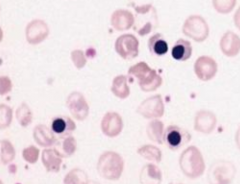
What are the large dots?
|
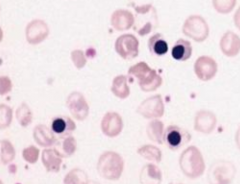
Nucleated RBCs
|
|
|
What are the effects of inadequately transfused β-thalassemia major?
|
- Stunted growth
- Frontal bossing - "Mongoloid" facies - Increased skin pigmentation - Characteristic bony abnormalities - Fever - Wasting - Hyperuricemia - Spontaneous fractures - Hepatosplenomegaly - Infections - Folate deficiency - Death in childhood |
|
|
What are the features of adequately transfused β-thalassemia major?
|
- Normal early development
- Avoidance of classic complications - Additional features depend on whether there is adequate iron chelation therapy |
|
|
What are the features of adequately transfused β-thalassemia major without adequate iron chelation therapy? Prognosis?
|
- Absence of pubertal growth spurt and menarche
- Endocrine disturbances such as DM, adrenal insufficiency - Death from cardiac disease by end of 3rd decade |
|
|
What are the features of adequately transfused β-thalassemia major with aggressive iron chelation therapy? Prognosis?
|
- Less severe cardiac disease and endocrine disturbances
- Significantly improved life-span |
|
|
What is necessary to have a good life-span with β-thalassemia major?
|
Adequately transfused w/ aggressive iron chelation therapy
|
|
|
What are the features of β-thalassemia minor?
|
- Heterozygous
- Asymptomatic - Discovered incidentally |
|
|
In what populations is β-thalassemia minor more common?
|
- Common in Mediterranean and Asian populations
- 1.5% of African Americans |
|
|
What are the lab features of β-thalassemia minor?
|
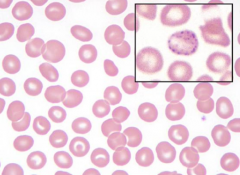
- Mild or no anemia (Hb>~10g)
- Microcytosis (50-70 fL) - Mild anisopoikilocytosis w/ scattered target cells - Basophilic stippling - Elevated HbA2: 3.5-7% |
|
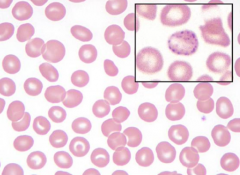
What does this image show?
|
β-thalassemia minor:
- Microcytosis (50-70 fL) - Mild anisopoikilocytosis w/ scattered target cells - Basophilic stippling |
|
|
What are the features of β-thalassemia intermedia?
|
- Heterogenous group
- Intermediate severity between major and minor |
|
|
What causes α-thalassemia?
|
Gene deletion of α-gene(s)
|
|
|
What are the clinical subtypes of α-thalassemia?
|
- Silent carrier (1 α gene deleted)
- α-thalassemia trait (2 α genes deleted) - Hemoglobin H disease (3 α genes deleted) - Hydrop Fetalis (4 α genes deleted) |
|
|
What is it called when 2 α-globin genes are deleted?Symptoms?
|
α-Thalassemia Trait
- Mild microcytic anemia similar to β-thalassemia minor - Discovered incidentally |
|
|
What is it called when 3 α-globin genes are deleted?Symptoms?
|
Hemoglobin H Disease
- Mild to moderate, chronic hemolytic anemia - HbH represents β-tetramers (excess form tetramers) - does not effectively transfer O2 - HbH soluble, so does not initially precipitate in normoblasts (no intramedullary cell death) - unstable over time, so precipitates in circulating RBCs, causing hemolysis |
|
|
What is it called when 4 α-globin genes are deleted?Symptoms?
|
Hydrops Fetalis
- Infants are either stillborn or die within first few hours of life |

